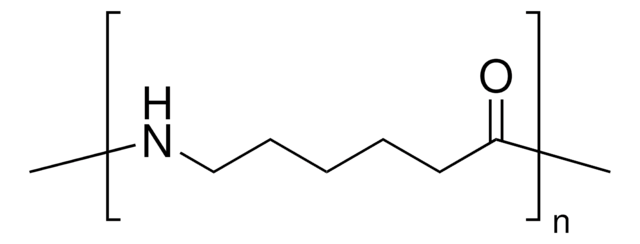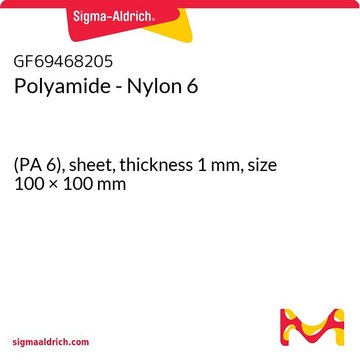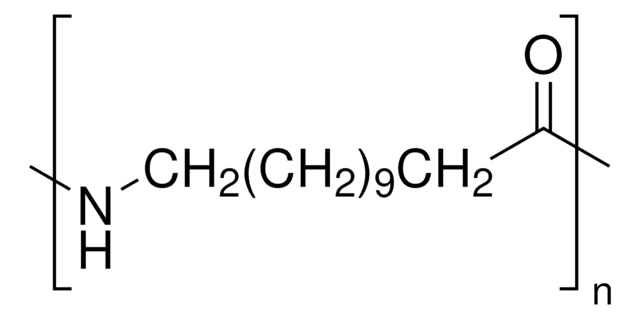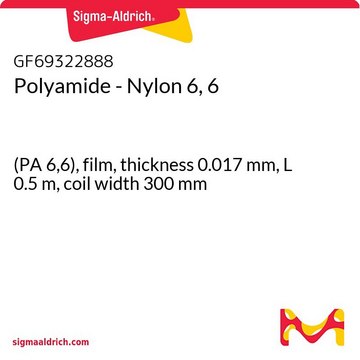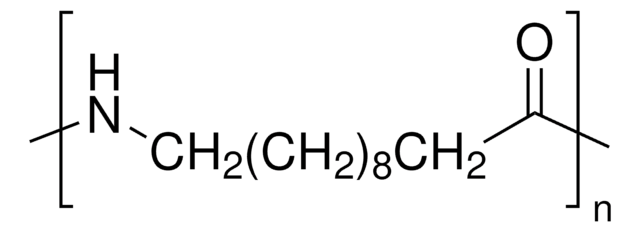All Photos(3)
About This Item
Linear Formula:
[-NH(CH2)5CO-]n
CAS Number:
MDL number:
UNSPSC Code:
12162002
PubChem Substance ID:
NACRES:
NA.23
Recommended Products
form
pellets
Quality Level
autoignition temp.
815 °F
transition temp
Tm 228.5 °C
Tg 62.5 °C
density
1.084 g/mL at 25 °C (lit.)
SMILES string
NC(=O)CCCCC
InChI
1S/C6H13NO/c1-2-3-4-5-6(7)8/h2-5H2,1H3,(H2,7,8)
InChI key
ALBYIUDWACNRRB-UHFFFAOYSA-N
Looking for similar products? Visit Product Comparison Guide
Related Categories
Application
Nylon 6 can be used as starting material to prepare:
- Silica nanoparticles–nylon 6 composites for extraction of hormones from aqueous samples.
- Polymeric nanofibers by electrospinning method. These nanofibers can be used to fabricate highly efficient nanofilters.
Storage Class Code
11 - Combustible Solids
WGK
WGK 3
Flash Point(F)
Not applicable
Flash Point(C)
Not applicable
Choose from one of the most recent versions:
Already Own This Product?
Find documentation for the products that you have recently purchased in the Document Library.
Customers Also Viewed
Anna Lindqvist et al.
Perception, 41(11), 1373-1391 (2012-01-01)
Twenty participants scaled similarities in odour quality, odour intensity and pleasantness/ unpleasantness of 10 binary and 5 higher-order mixtures of 5 odorous degradation products from the polymer Polyamide 6.6. The perceived odour qualities of all binary mixtures were represented well
Fei Hang et al.
Nanotechnology, 22(36), 365708-365708 (2011-08-17)
A nanomechanical testing set-up is developed by integrating an atomic force microscope (AFM) for force measurements with a scanning electron microscope (SEM) to provide imaging capabilities. Electrospun nanofibers of polyvinyl alcohol (PVA), nylon-6 and biological mineralized collagen fibrils (MCFs) from
Seiji Negoro et al.
The Journal of biological chemistry, 287(7), 5079-5090 (2011-12-22)
We performed x-ray crystallographic analyses of the 6-aminohexanoate oligomer hydrolase (NylC) from Agromyces sp. at 2.0 Å-resolution. This enzyme is a member of the N-terminal nucleophile hydrolase superfamily that is responsible for the degradation of the nylon-6 industry byproduct. We
Hem Raj Pant et al.
Journal of colloid and interface science, 364(1), 107-111 (2011-09-06)
In this work, different fractions of solvent-induced polymer degraded solution were mixed with freshly prepared solution of same polymer, and its effect on fiber morphology of electrospun mats was investigated. Nylon-6 solution in formic acid was allowed to degrade for
Habib Bagheri et al.
Analytica chimica acta, 716, 34-39 (2012-01-31)
A novel solid phase microextraction (SPME) fiber was fabricated by electrospinning method in which a polymeric solution was converted to nanofibers using high voltages. A thin stainless steel wire was coated by the network of polymeric nanofibers. The polymeric nanofiber
Our team of scientists has experience in all areas of research including Life Science, Material Science, Chemical Synthesis, Chromatography, Analytical and many others.
Contact Technical Service
